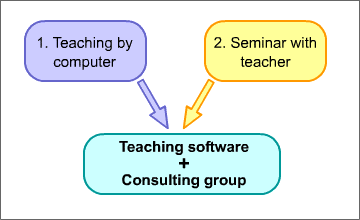
Fig. 1. Integration of two training systems �Computer + Teacher�.
On-Line Training System �TRIZ-trainer�
by
Abstract. The process of introducing TRIZ into companies normally starts with solving real production problems by involving TRIZ consultants in this work. After significant results have been obtained and some positive experience has been accumulated in this direction, the company�s interest changes. A considerable interest arises in teaching the problem-solving methods to the company�s employees. The purpose of such training is to improve the technical level of all employees and to prepare a certain number of high-skilled specialists in problem solving with the aid of TRIZ. This paper describes our approach to the training of company�s employees, which is realized with the aid of the online training system �TRIZ-trainer� developed and used at SAMSUNG (South Korea).
Introduction. Along with solving real production problems, another important stage of introducing TRIZ into companies is training of its employees. The main problem that usually arises in this connection is deficiency of time. As least two weeks are needed for studying TRIZ at the initial level, while the full-scale training course will take about two months. For this period, every trainee must suspend performance of his daily functions, which is not always possible.
How can we resolve this situation by using TRIZ?
Training form. There exist two basic forms of training - seminars under the guidance of a teacher and training with the aid of computer programs.
According to Table 1, seminars held by an experienced teacher are fairly efficient, but great time and money expenses per one employee make this form of training inaccessible to most employees of a company. In addition, the choice of students for such seminars is arbitrary, without considering individual peculiarities. In this case, it is not always possible to select employees who are really adequate for consulting work. The employee�s adequacy or inadequacy for this kind work is often detected only after completing the training course, when time and money have already been spent.
Training with the aid of computer programs practically does not encroach upon the employees� working hours and does not require expenses. With sufficient motivation, each employee may be trained independently during rest periods or in his free time. However, the efficiency of such training is not high, since computer programs do not take into account individual peculiarities of trainees. A contradiction occurs between the training efficiency and the time and money expenses for organizing the training process.
Table 1.
| Training process characteristics | Training under the guidance of a teacher | Computer training |
| 1. Efficiency 2. Cost 3. Time expenses 4. Possibility to teach all employees | + - - - | - + + + |
Thus, we have two alternative training systems and we can resolve the contradiction of this situation by combining these systems in accordance with the methods proposed by S.Litvin and V.Gerasimov (1).

Fig. 1. Integration of two training systems �Computer +
Teacher�.
In the combined training system, the basic information and check tasks must be presented on electronic information carriers and must be accessible to a trainee any time a day, for instance, through Internet or a company�s intranet. A teacher receives and evaluates fulfilled check tasks. He can also answer the arising questions and help a trainee perform, in the most rational way, actions necessary for problem solving. In this case, personal contact of a trainee and a teacher is unessential. Thus, the advantages of two competing training systems are combined.
Seminar or training? Which method is more suitable for our online system?
Generally speaking, there are two teaching methods.
The first one - we�ll conventionally call it academic - consists in that a full-scale theory of a subject is given to a trainee and then the obtained knowledge is solidified by solving special training problems. This requires much time and the presence of a teacher is essential. The purpose of such teaching is to provide a student with knowledge that subsequently is supplemented and solidified by permanent exercises.
The second method is training. In this case, a trainee is proposed to fulfill some action, while theoretical knowledge is attracted when it is necessary and insofar as it is necessary. The example is training any recurring action, for instance, driving a car or flying a plane. The purpose of the training is to work out a skill of fulfilling this action. Further training follows the path of deepening the theoretical knowledge essential for understanding the meaning that is behind the fulfilled actions.
Since the purpose of the initial system is to provide a student with problem-solving skills, training is more suitable for an online system.
Structure. To efficiently teach problem solving with the aid of training, we must have a distinct problem solving structure. Then we can repeat the solving process many times thus explaining and training the peculiarities of performing each action. In real use of TRIZ, several approaches to problem solving are employed (2, 3).
1. In a random way
In this case, a problem is solved by that TRIZ tool, in terms of which it is formulated. For instance, if the conditions of a problem seem to contain a technical contradiction, then the solver will first of all look for a method for resolving that contradiction. If the problem�s condition is described through the interaction of two or more objects, standards or effects are used. Such an approach allows for solving the problem but is inconvenient for teaching since the information is dispersed about several sections of TRIZ.
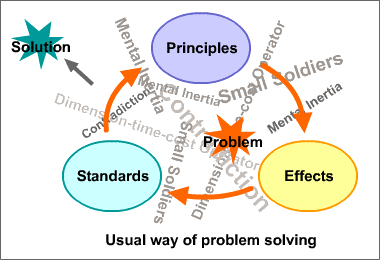
Fig. 2. Problem solving in case of insufficient
understanding of TRIZ.
2. Using ARIZ
ARIZ offers a distinct problem-solving scheme, but its structure seems too rigid and requires a prolonged preliminary study. Besides, ARIZ is a tool for solving complex acute contradictions, which is not frequent in practice.
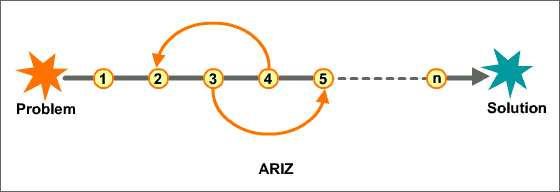
Fig. 3. Solving a problem according to ARIZ
3. Using main postulates of OTSM
The OTSM approach developed recently by N.Khomenko is more attractive in this respect (4, 5). The narrowing, distinctly confined search area implies at the same time a certain degree of freedom of actions within this area.
In addition, OTSM envisages actions in accordance with classical Cartesian cognitive scheme - �transfer from a specific situation to its abstract models; transformation of those models; building a specific solution�, which is more comprehensible to engineers who received a traditional education.
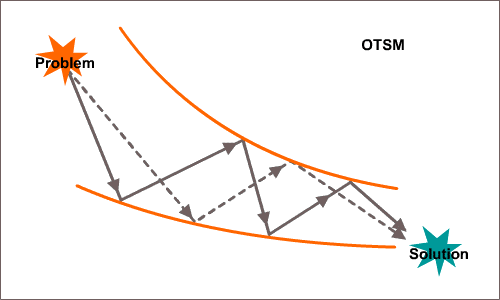
Our approach is as follows. To develop the most suitable structure of problem solving, it is expedient to combine OTSM with ARIZ elements. This can be done by rigidly presetting several key points in the solving process and allowing more or less free transfers between them. The authors developed this structure on the basis of a multi-year experience in solving real problems. The structure is elucidated by the �Christmas Tree� diagram, which is described in detail in the January issue of the TRIZ journal
(http://www.triz-journal.com/archives/2002/01/f/index.htm).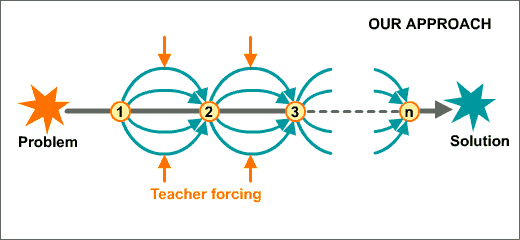
Fig. 5. The proposed approach to problem solving.
TRIZ-trainer. Based on this approach, which we have been developing by solving real production problems during many years, SAMSUNG (Korea) developed an on-line training system �TRIZ-trainer�
http://www.triztrainer.com.

Fig. 6. TRIZ-trainer home page.
The information offered by TRIZ-trainer to a student on a computer�s screen is grouped into several functional blocks, the main of which are:
1. Check Tasks.
The Check Tasks block offers a set of problems accompanied by a possible solution structure. The conditions of the problems are explained by animated illustrations (Fig. 7).
2. Problem Analysis.
This block offers a detailed analysis of training and real production problems built in accordance with the �Christmas Tree diagram� (Fig. 8).
Fig. 8. Problem analysis.3. Solving Procedure.
This part of TRIZ-trainer contains the necessary theoretical information about key points of the problem-solving process and transfers between them (Fig. 9).
The training system �TRIZ-trainer� ensures a convenient interaction between a trainee and a teacher through the communication section. Owing to this, a trainee can ask any question at any moment, while a teacher has an opportunity to evaluate the individual abilities of each student. This structure allows a teacher to simultaneously control a group of students, while students have an opportunity to permanently consult with their teacher whenever they need.
In addition, there is a glossary with short definitions of notion used in TRIZ-trainer, and references to used and recommended literature for self-improvement.
Structure of training the company�s employees. The use of the on-line training system �TRIZ-trainer� in addition to the traditional methods (a series of successive seminars under the guidance of a teacher) allows obtaining a number of advantages. A possibility appears to organize training of the company�s employees in several stages, the complexity of the material being increased from stage to stage (Fig. 10).
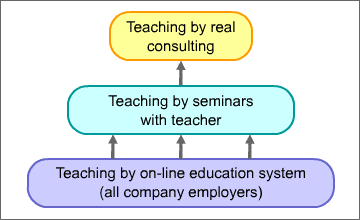
Practically all employees of a company can participate in the first, initial stage of training conducted with the aid of the system �TRIZ-trainer�. The students will get initial knowledge on TRIZ and problem-solving skills. At this stage, a student can master the logic of building a solution by solving a certain number of training problems. After the initial stage, the most capable employees are selected and recommended for further training at seminars under the guidance of a teacher.
At the second stage, a student can improve his knowledge obtained with the aid of TRIZ-trainer, thoroughly study the theoretical foundations of TRIZ and have an in-depth practice at solving training and real problems under the guidance of an experienced teacher.
The final stage of training is probation of employees in solving real problems under the guidance of an experience TRIZ consultant. At this stage, one can achieve a deeper understanding of the theoretical basics of problem solving and acquire practical skills in identifying and solving the problems available in a real production situation. One can learn to make a purposeful search for information while working with the specialists of a customer�s team and work out the skills to evaluate and select the best solution for a given situation.
Conclusions.
Teaching the basics of problem solving with the aid of the on-line system �TRIZ-trainer� is highly efficient.
The training cost per one student is much lower that that of seminars under the guidance of a teacher.
A student can study at any convenient time.
Any employee of a company can take the course.
Efficient advertising of TRIZ-trainer is provided among employees and managers of a company.
The on-line system �TRIZ-trainer� is easily integrated into the traditional education structure of the company�s specialists.
List of References
|
�
Copyright 1997-2005 CTQ Media LLC |